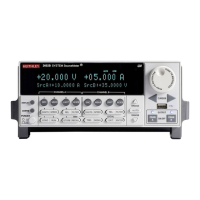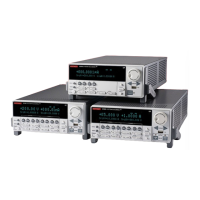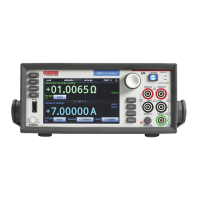3-4 Test Script Processor Interaction Series 2600 System SourceMeters User’s Manual
2600S-900-01 Rev. A / May 2006 Return to In this section:
Running a factory script
Reference Refer to “Factory scripts” in Section 2 of the Series 2600 Reference
Manual for details on running factory scripts.
The following steps explain how to run the PulseVMeasureI function and read
the data stored in the buffer.
Step 1: Call the function
The following are example parameters for the PulseVMeasureI function which
will perform three pulse voltage, measure current cycles:
smu = SMU A level = 1V toff = 2ms
bias = -1V ton = 1ms points = 3
The following command will execute the PulseVMeasureI function using the
above parameters:
PulseVMeasureI(smua, -1, 1, 1E-3, 2E-3, 3)
Step 2: Read the buffer
Reference Refer to Section 7 of the Series 2600 Reference Manual for details
on the reading buffers.
The above function stores the three current measurements in the reading buffer
(
smua.nvbuffer1). Also stored in the buffer are the voltage source settings and
timestamps for the measurements. The timestamps (in seconds) are referenced
to the start of the test. The timer for the timestamps starts at zero seconds when
the test is started.
The printbuffer function is used to print (output) measured readings,
timestamps and/or source values stored in the buffers.
Print readings – The following code will return the three measured current
readings stored in
nvbuffer1:
rb1 = smua.nvbuffer1
printbuffer(1, rb1.n, rb1)
Example output: 1.234567e-03, 2.362360e-03, 2.362368e-03
For the above printbuffer function, 1 is the starting index for values to print,
rb1.n is the ending index (for this function, n = 3), and rb1 is the reading buffer
(
smua.nvbuffer1).
NOTE All commands to run a factory script are to be executed
from the Instrument Console of the Test Script Builder.
NOTE The “KIGeneral” factory script is an autorun script. The
script runs automatically when the Series 2600 is turned on.
The functions of the script are ready to be called.

